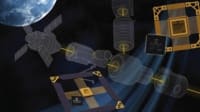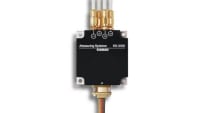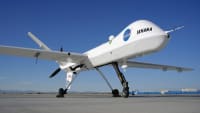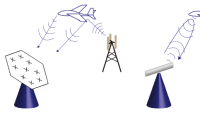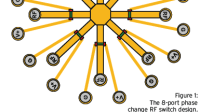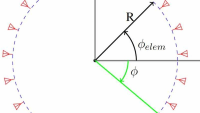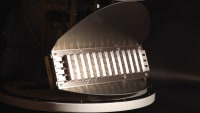Transforming Satellite Antenna Technology for the Next Era of Aerospace and Defense

The global satellite communications (SATCOM) sector is undergoing profound transformation. Fueled by the rapid growth of low Earth-orbit (LEO) constellations, increased government investment, and heightened demand for secure, high-throughput connectivity, the market is projected to expand from $66.75 billion in 2025 to $103.78 billion by 2029 1, 2.
This momentum reflects a broader realignment of priorities across commercial and defense markets: a shift from reliance on legacy geostationary systems toward agile, resilient networks capable of supporting next-generation missions and applications.
The Rise of LEO Constellations and the Demand for Change
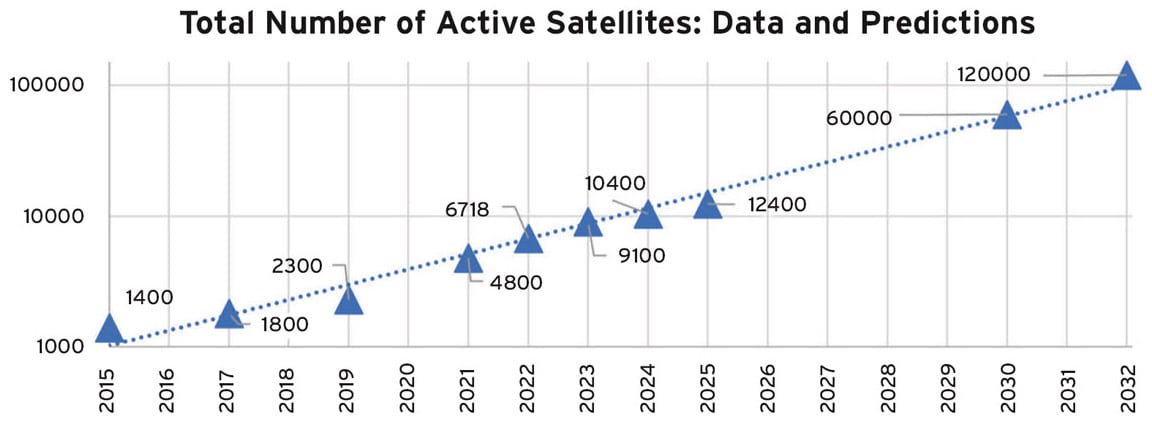
A decade ago, approximately 1,000 active satellites orbited the Earth. Today, that number approaches 10,000, the majority residing in LEO 3, and is predicted to exceed 100,000 by 2032, as shown in Figure 1. This dramatic expansion, as reported by the International Telecommunication Union (ITU), has been enabled by advances in satellite miniaturization, manufacturing, and launch technologies, creating constellations that provide persistent, low-latency global coverage 3.
The ITU emphasizes that the LEO revolution is reshaping both the economics and architecture of satellite communications, enabling a global mesh network that supports remote sensing, secure communications, and broadband services at unprecedented scale.
For aerospace and defense operators, this shift carries strategic importance. Rapid deployment and replenishment of satellites have become operational imperatives, supporting functions ranging from secure command and control to intelligence, surveillance, reconnaissance (ISR), and resilient communications in contested environments 4. The smaller, lighter satellites and terminals demanded by these missions are not just more economical; they are vital for operational flexibility and mission success.
Why Traditional Antenna Solutions Fall Short
Despite significant progress in satellite bus design and launch capabilities, antenna technology has emerged as a bottleneck for next-generation systems. Traditional flat panel phased array antennas, typically built on silicon and printed circuit board (PCB) substrates, face challenges in scaling to higher frequencies and larger apertures without significant penalties in size, weight, power, and cost (SWaP-C) 5, 6.
In many modern satellite platforms, antennas account for up to 20 percent of total payload mass, directly impacting launch costs and constraining the ability to integrate additional sensors or extend mission lifetimes 4.
Aerospace and defense stakeholders recognize this issue. Phased array antennas are now becoming essential for the type of performance required to enable next-generation radar and communications applications, offering advantages such as rapid electronic beam steering, multi-beam operation, and resilience to jamming and electronic countermeasures. However, improvements in SWaP-C remain critical to unlocking the full potential of these technologies.
Kythrion: A Platform Engineered for the Modern Mission
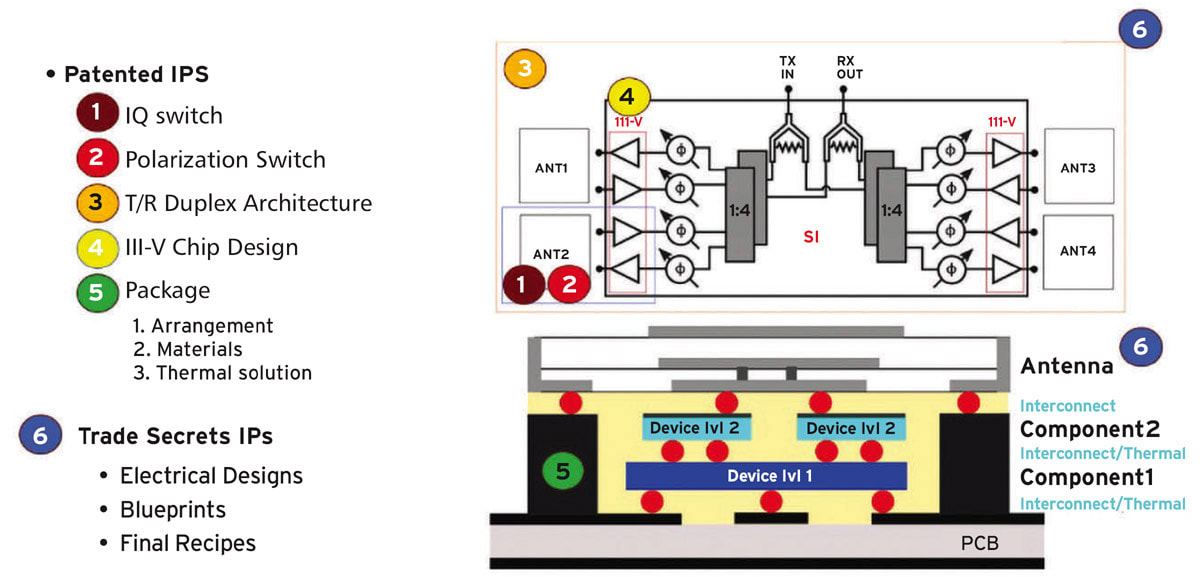
To address these challenges, Circuits Integrated Hellas (CIH) has developed Kythrion, a new antenna platform that leverages 3D heterogeneous integration (see Figure 2). Founded in 2019, CIH is a startup that is attempting to bring advanced semiconductor technologies that merge III-V materials and silicon in groundbreaking 3D integrated circuit stacks to satellite communications. At the inaugural Farnborough International Space Show in February, CIH was named the winner of the “Innovation Award in Space” for their Launch Pad startup competition.
By combining III-V compound semiconductors, such as gallium arsenide (GaAs) and gallium nitride (GaN), with silicon technologies in a 3D system-in-package (SiP) / antenna-in-package (AiP) architecture, Kythrion achieves substantial performance gains. As noted in an interview with CTO of British semiconductor company IQE plc featured in the September 2024 issue of Sensor Technology, a sister publication to Aerospace & Defense Technology, the specific class of compound semiconductors known as III-V materials are those that combine two or three different chemical elements from column III and V on the periodic table. They’re known for outperforming silicon in power and speed, although the key to leveraging this performance boost is to mate them with silicon. These compound semiconductors are capable of operating at higher frequencies, higher voltages and higher temperatures. They also have the ability to emit and absorb light.
CIH’s proprietary chip solution heterogeneously integrates high-performance power amplifiers, phase shifters, and other critical RF components together in a compact package, thus reducing the antenna footprint required for these components by up to 78 percent compared to today’s flat panel antenna configurations.
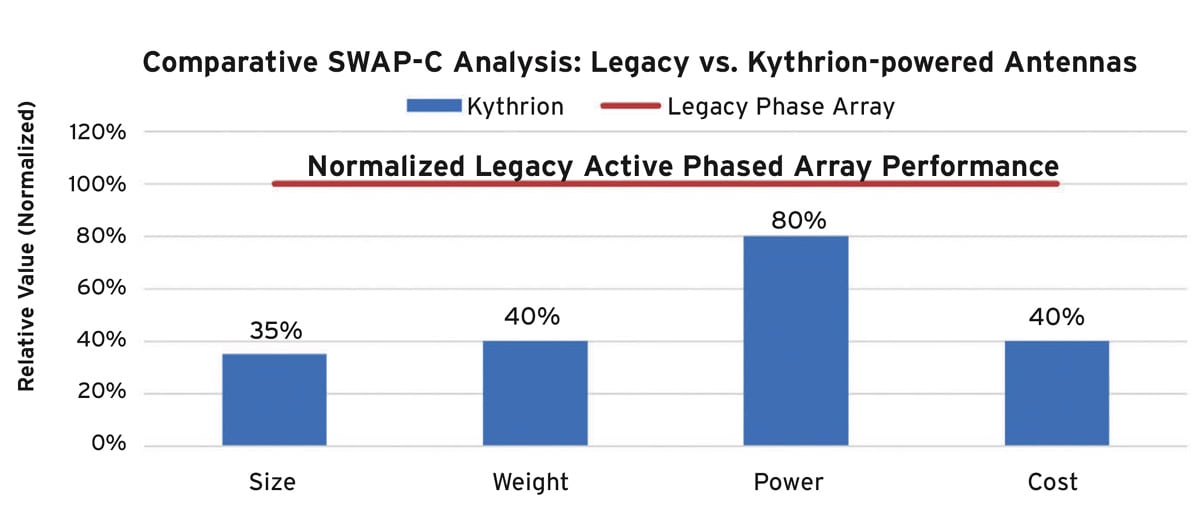
As shown in Figure 3, compared to legacy phased array modules, Kythrion delivers:
Greater than 60 percent reductions in antenna size, weight, and cost.
More than 15 percent improvements in power efficiency for equivalent effective isotropic radiated power (EIRP) and gain-to-noise-temperature ratio (G/T).
These enhancements enable a new generation of lightweight, agile, and scalable SATCOM terminals, suitable for both spaceborne and terrestrial applications.
The technical advantages of this approach are tightly aligned with operational needs. Kythrion’s compact form factor reduces mass, freeing capacity for additional payloads or fuel reserves. Its improved efficiency reduces both power consumption and thermal load, supporting longer mission durations and more demanding operational profiles. Critically, the platform’s modularity and scalability allow customization for specific mission profiles, including multi-beam tracking and software-defined networking applications.
Broader Trends Shaping the Satellite Communications Industry
The drive for innovation extends beyond technical domains. Geopolitical factors and public policy are accelerating the adoption of advanced satellite technologies. Recent analysis by The Business Research Company highlights that government investment and modernization initiatives are key drivers of SATCOM market growth, particularly around LEO constellation deployment and military communications upgrades 1, 6 .
Simultaneously, the democratization of launch and satellite manufacturing, spurred by reusable rockets and new commercial entrants, has shifted cost pressures away from launch services and satellite buses, placing new emphasis on the ground segment. High-performance, cost-effective antennas are increasingly viewed as the primary lever for driving system-wide cost reductions and supporting rapid scaling.
As the global market for satellite data services is forecasted to reach $55.24 billion by 2034, demand for efficient, scalable antenna solutions is set to intensify 7.
Advanced Integration: Unlocking the Next Leap
Advanced semiconductor integration is poised to enable the next leap in SATCOM performance. Merging III-V materials and silicon in compact, high-efficiency packages offers clear advantages in power density, frequency scaling, and thermal management.
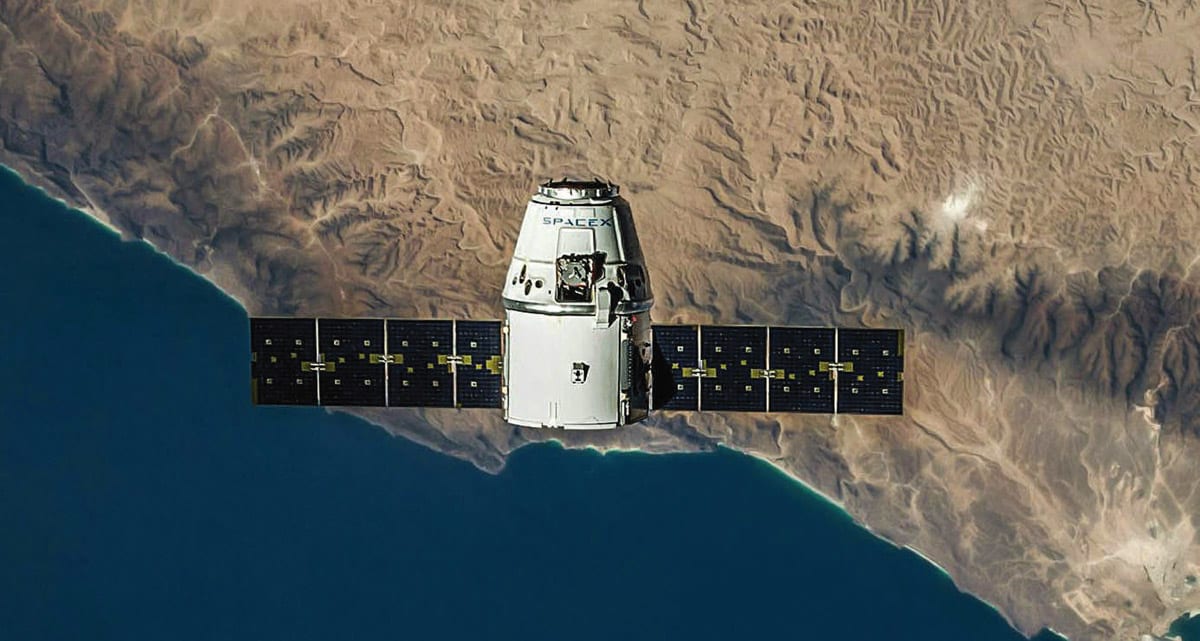
Once a specialized technology reserved for defense radar systems, phased array antennas have become central to modern satellite communications. They offer beam agility, multi-beam capability, and electronic reconfiguration without moving parts5, 6 — capabilities that align well with the dynamic and contested environments envisioned for future aerospace and defense missions.
The aerospace and defense satellite communications sector stands at the threshold of a generational shift. As demand accelerates for resilient, secure, and global connectivity, the limitations of traditional antenna technologies have become increasingly evident. Solutions like Kythrion, with their high degree of integration and performance optimization, are positioned to set new industry benchmarks for size, weight, cost, and capability.
References:
- The Business Research Company. “Satellite Communication Market Report 2025.”
- International Telecommunication Union (ITU). “Space Connect: The rise of LEO satellite constellations.”
- DataHorizzon Research. “Phased Array Antenna Market Size, Growth, Scope & Fore-cast.”
- Precedence Research. “Satellite Data Services Market Size to Hit USD 55.24 Billion by 2034.”
- Mordor Intelligence. “LEO Satellite Market Size & Share Analysis - Industry Research Report.”
- Allied Market Research. “Military Antenna Market Size, Trends Analysis and Forecast 2033.”
- GlobeNewswire/SNS Insider. “Satellite Communication Market to grow USD 194.55 Billion by 2032.”
All statements and data are substantiated by the cited external references and reflect the latest available research and industry analysis as of April 2025.
This article was written by Paolo Fioravanti, CEO, Circuits Integrated Hellas (Kifissa, Greece). For more information, visit here .
Top Stories
INSIDERDefense
![]() New 3D-Printable Nanocomposite Prevents Overheating in Military Electronics
New 3D-Printable Nanocomposite Prevents Overheating in Military Electronics
Technology ReportSoftware
![]() Talking SDVs and Zonal Architecture with TE Connectivity
Talking SDVs and Zonal Architecture with TE Connectivity
NewsDesign
![]() 2026 Nissan Sentra Review: Putting the Pieces Together
2026 Nissan Sentra Review: Putting the Pieces Together
INSIDERDesign
![]() New Defense Department Program Seeks 300,000 Drones From Industry by 2027
New Defense Department Program Seeks 300,000 Drones From Industry by 2027
INSIDERDefense
![]() Anduril Completes First Semi-Autonomous Flight of CCA Prototype
Anduril Completes First Semi-Autonomous Flight of CCA Prototype
INSIDERDefense
Webcasts
Transportation
![]() Hydrogen Engines Are Heating Up for Heavy Duty
Hydrogen Engines Are Heating Up for Heavy Duty
Manufacturing & Prototyping
![]() SAE Automotive Podcast: Solid-State Batteries
SAE Automotive Podcast: Solid-State Batteries
Manufacturing & Prototyping
![]() SAE Automotive Engineering Podcast: Additive Manufacturing
SAE Automotive Engineering Podcast: Additive Manufacturing
Defense
![]() A New Approach to Manufacturing Machine Connectivity for the Air Force
A New Approach to Manufacturing Machine Connectivity for the Air Force
Automotive
![]() Optimizing Production Processes with the Virtual Twin
Optimizing Production Processes with the Virtual Twin









